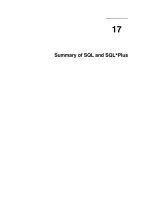Tài liệu Principles of Women’s Health Care docx
Bạn đang xem bản rút gọn của tài liệu. Xem và tải ngay bản đầy đủ của tài liệu tại đây (225.05 KB, 8 trang )
Principles of Women’s Health Care
Women’s Health NSW aims to provide a strong independent public voice on
women’s health and wellbeing from a feminist, wholistic perspective that
values women’s safety and dignity
2
This document and fact sheet was prepared by
Women’s Health NSW
PO Box 341
Leichhardt NSW 2040
Australia
+61 (0)2 9560 0866 Phone
+61 (0)2 9560 2887 Fax
www.whnsw.asn.au Web
20 February 2007
To find your local Women’s Health Centre in NSW: www.whnsw.asn.au
3
Women’s Health NSW
Women’s Health NSW is the peak body for, and industry association of, non-
government, community, feminist women's health centres in New South Wales.
In addition, we are responsible for promoting a coordinated approach to policy and
planning, staff development, training, education and consultation between
members, NSW Health and other government and non-government agencies.
There are twenty-three member centres that provide a diverse range of services to
women in their communities in New South Wales. Throughout the network service
provision is influenced by the identified needs of local communities and a common
aim of working to improve the health status of women.
Strategies incorporated by Women’s Health Centres include preventative health
care, community education and development, advocacy and empowerment;
providing women with knowledge, skills and resources to enable them to take more
responsibility over factors that may adversely affect their lives.
Member services operate from a feminist perspective and link the cause of ill
health in women to a multiplicity of factors including biological, social, cultural,
environmental and economic. These factors influence women’s health status, their
need of health services and their ability to access appropriate services.
Our Vision
That all women and girls are empowered to fulfil their potential within a safe and
healthy environment
Our Role
Women’s Health NSW works within a feminist framework to improve health and
social justice outcomes for women
The Women’s Health NSW website outlines the structure, aim, history and
philosophy of Women’s Health NSW
For anyone looking to find their nearest Women’s Health Centre, our website has
an information page on each Women’s Health Centre in NSW outlining their
contact details and range of service provision. www.whnsw.asn.au
4
Principles of Women’s Health Care
Community based feminist women's health services are based on principles of
social justice and an understanding of a gendered approach to health or health
within a social context, as endorsed by governments throughout Australia. This
endorsement was originally expressed in the National Women's Health Policy
(1989) Advancing Women’s Health in Australia and subsequently in various State
and Territory broader policy frameworks for health priorities that have a gender
view of health such as the Women’s Health Outcome Framework developed by
NSW Health (2002).
This view recognises that:
i
health is determined by a broad range of social, environmental, economic
and biological factors
i
differences in health status and health objectives are linked to gender, age,
socio-economic status, ethnicity, disability, location and environment,
racism, sex-role stereotyping, gender inequality and discrimination, ageism,
sexuality and sexual preferences
i
health promotion, disease prevention, equity of access to appropriate and
affordable services and strengthening the primary health care system are
necessary, along with high quality illness treatment services
i
information, consultation, advocacy and community development are
important elements of the health process.
In accordance with these principles, feminist women's health centres provide a
service which:
i
encompasses all of women's lifespans, and reflects women's various roles
in Australian society, not just their reproductive role
i
promotes the participation of women in debate and decision making about
health issues, their own health care, health service policy, planning,
delivery and evaluation
i
recognises women's rights, as health care consumers, to be treated with
dignity, in an environment which provides for privacy, informed consent,
confidentiality and safety
i
acknowledges that informed decisions about health and health care require
accessible information, which is appropriately targeted for different socio-
economic, educational and cultural groups
5
i
uses existing data, research and policy concerning women's health, as well
as incorporating women's views about their own health and the best
strategies to address their health needs, in service planning and
development
i
provides appropriate women's health care to women in local communities,
within a state-wide, co-ordinated approach
i
ensures equity and accessibility of services without financial, cultural,
geographic and or other barriers.
i
ensures effective community management and operation of women's
health centres by women, for women
i
provides a broad range of services and strategies within a preventive and
holistic framework, which:
i
is provided by women, for women
i
values women's own knowledge and experience
i
facilitates the sharing of women's skills, knowledge and
experience
i
links women's individual experience and health needs to the
social and cultural context of women's lives
i
empowers women
i
challenges sex-role stereotyping, gender discrimination, racism
and homophobia which affect health
i
increase the accessibility, sensitivity and acceptability of health
services for women
i
relates to identified health priorities at the local and state level.
These principles are expressed in the Australian National Women's Health
Policy (1989) and the Manual of Standards For Women's Health Centres
(2005). They are also articulated in NSW Health Strategic Framework to
Advance the Health of Women (2000) at:
www.health.nsw.gov.au/policy/hsp/women/stratdirwomen.pdf
Additional information can be viewed on our website: www.whnsw.asn.au
6
Women’s Health Status
Women are still the major users of health services. They report more episodes
of ill health, consult medical practitioners, chemists and other health
professionals more frequently and take medication more often. Women have
higher rates of hospital use both during their reproductive years and after the age
of 70. Women comprise of 72 per cent of those in nursing homes and long-stay
institutions and report a higher prevalence of psychosocial problems than men –
particularly severe and chronic depression. Women’s Health Services in NSW
(1985).
A multiplicity of factors including biological, social, cultural, environmental and
economic, influence women’s health status, their need of health services and
their ability to access appropriate services. In particular women’s health needs
stem from the fact that:
• Women are more socially disadvantaged than men in terms of poverty,
education and power. Socially disadvantaged people are more likely to
become ill
• Women are more likely to use health services because of their social role
as carers of children, older people, or people with disabilities and the extra
strain this places on their health
• Women have particular sexual and reproductive health needs, for
example, menses, pregnancy, childbirth and menopause
• Women are treated differently from men in society generally because of
gender inequality resulting in, for example, violence against women and
sexual assault. The Women’s Safety Survey (1996) conducted by the
Australian Bureau of Statistics, found that 5.9 per cent of women surveyed
had experienced physical violence in the previous 12 month period, and a
further 1.5 per cent had been sexually assaulted. On a population basis,
these combined figures represent 490,000 women across Australia
• Women are also treated differently within the health system. For example,
Williams et al (1995) conducted a major study examining gender
differences in depression. The study found that women were almost twice
as likely as men to be diagnosed with depression and/or anxiety disorders
and major and/or longstanding depressive disorders. The study also
found that women diagnosed with depression were significantly more
likely to be prescribed antidepressant drugs than men with the same
diagnosis. Strategic Framework to Advance the Health of Women (2000).
www.health.nsw.gov.au/policy/hsp/women/stratdirwomen.pdf
7
• Women have frequently been excluded from being health and medical
research participants leading to major gaps in knowledge about women’s
health. Even when women are included in “people” research the results
are often not analysed in terms of gender so differences between men and
women are often not known, or an assumption is made that women are
affected the same as men. This can lead to prevention, intervention and
policy decisions that adversely affect women.
It was because of these and other factors that women in the community, feminist
women, applied for and received funding from the Australian Commonwealth
Community Health Program in 1974. Services were also developed using a
socio-political, feminist analysis that highlighted the patriarchal nature of society
and the oppression of women. For many years, women have argued for an
understanding of a social view of health, highlighting the links between health
status and the social position of women in society.
There are now 22 community managed women’s health services funded by the
NSW Health Department. They are complemented by various projects funded
under other women’s health initiatives. While the services vary in focus and size,
their core principles remain consistent with those expressed in this document.
The following definition of women’s health was endorsed by the Australian Health
Minister’s Advisory Council in 1993:
“The advancement of women’s health requires the promotion of physical, mental
and social well being, following the broad definition of health adopted by the
World Health Organisation. Women’s Health issues are defined as social
conditions, illnesses and disorders unique to, more prevalent among, or more
serious in women, or for which there are different risk factors, interventions or
strategies for women than for men.”
In 2000 NSW Health adopted a policy framework approach recognising that
gender leads to different social, economic and political opportunities for women
and men. These inequalities can create, maintain or exacerbate exposure to risk
factors that endanger health. They can also affect the access to and control of
resources, including decision making and education which protect and promote
health. Gender Equity in Health 2000.
The Women’s Health Services are actively involved in strategies to change the
social structure that negatively affect women’s health. At the same time they
provide appropriate individual, group and community services, information and
referral to women across Australia. The Nature of Women’s Health: Past;
Present; Future 2002.
8









